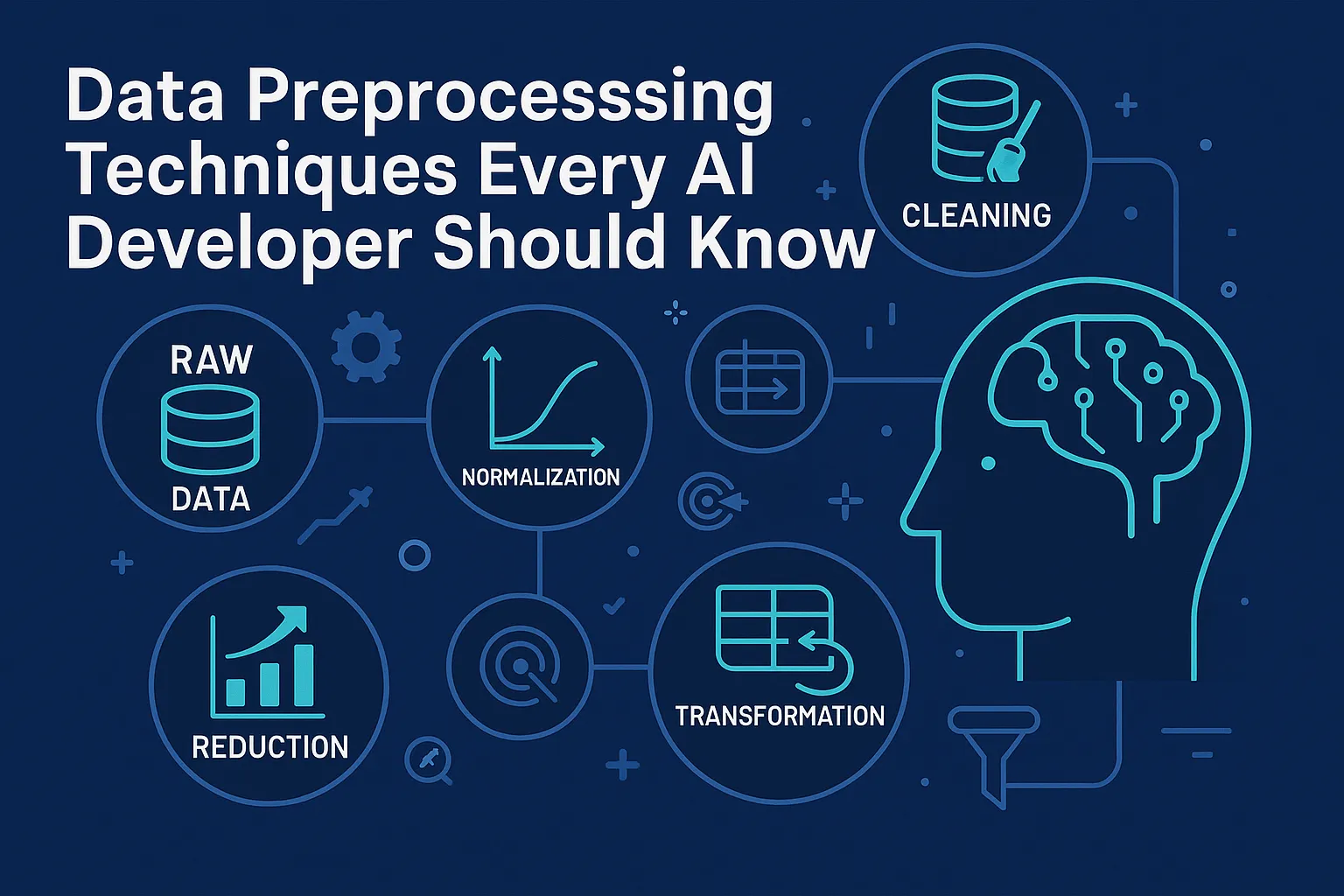
In machine learning, data preprocessing is the invisible foundation beneath every great model. Algorithms might grab the spotlight, but their success depends entirely on the quality of data they’re trained on. The saying “garbage in, garbage out” couldn’t be more true — no amount of clever architecture or tuning can compensate for poorly prepared data.
This guide explores the most important data preprocessing techniques every AI developer should master. You’ll learn not only what each method does, but when to use it, how it affects your model, and the subtle pitfalls to watch for in production.
Why Data Preprocessing Matters
Raw data is messy. It contains typos, missing values, inconsistent formats, extreme outliers, and sometimes even contradictory information. Preprocessing acts as the translator between this chaotic real-world input and the structured, numerical representation your model expects.
Good preprocessing can dramatically improve accuracy, reduce training time, and make models more robust in the wild. More importantly, it ensures fairness and consistency, reducing the risk of bias that might otherwise creep into automated decision-making.
1. Handling Missing Data
Almost every dataset you’ll encounter has missing values — blank cells, NaNs, or undefined entries. Ignoring them can lead to skewed analyses or even outright training failures.
There are two main strategies:
- Removal – Drop rows or columns with missing data. This is simple and safe if only a small fraction of entries are affected.
- Imputation – Fill missing values using statistical estimates (mean, median, mode) or model-based approaches (KNN imputer, regression). The goal is to preserve information while minimizing distortion.
For example, in healthcare data, if a patient’s blood pressure is missing, replacing it with the average value across patients of similar age and gender can retain useful signal without biasing results.
import pandas as pd
from sklearn.impute import SimpleImputer
df = pd.read_csv("data.csv")
# Simple median imputation
imputer = SimpleImputer(strategy="median")
df[["Age", "Income"]] = imputer.fit_transform(df[["Age", "Income"]])
When you impute, remember that missingness itself may carry meaning. You can add a binary feature (e.g., was_missing = 1) so your model learns whether the absence of data correlates with a target outcome.
2. Normalization and Standardization
Machine learning algorithms don’t inherently know the difference between “large” and “small” scales. Features measured in wildly different ranges (like income in thousands vs. age in years) can distort how distance-based models behave. Scaling brings all features into a comparable range.
- Normalization (Min-Max Scaling): Compresses all values into a fixed range, usually [0, 1]. Ideal for bounded features like pixel intensities or percentages.
- Standardization (Z-score Scaling): Rescales features to have zero mean and unit variance, which benefits algorithms that assume normally distributed data, like linear regression or logistic regression.
Neural networks and gradient descent-based models also train faster when features are standardized, as gradients become more stable and converge more efficiently.
from sklearn.preprocessing import StandardScaler, MinMaxScaler
scaler = StandardScaler()
df_standardized = scaler.fit_transform(df)
normalizer = MinMaxScaler()
df_normalized = normalizer.fit_transform(df)
As a rule of thumb, normalization helps when your data is bounded, while standardization helps when your data has outliers or no fixed limits.
3. Encoding Categorical Data
Models can’t process text labels directly — they need numerical representations. Encoding translates human-readable categories (like “Red”, “Blue”, “Green”) into numbers while preserving their structure.
- Label Encoding: Assigns an integer to each category. Works best for ordinal features (e.g., “Beginner” < “Intermediate” < “Expert”).
- One-Hot Encoding: Converts each category into a binary vector. Ideal for nominal features with no intrinsic order, like colors or city names.
- Target Encoding: Replaces categories with statistical values based on the target variable (e.g., mean target per category). Useful for high-cardinality features in large datasets.
from sklearn.preprocessing import OneHotEncoder, LabelEncoder
encoder = OneHotEncoder(handle_unknown="ignore")
encoded = encoder.fit_transform(df[["Category"]])
label_encoder = LabelEncoder()
df["Category"] = label_encoder.fit_transform(df["Category"])
Be mindful of one-hot encoding’s dimensionality explosion. If you have thousands of unique categories, consider hashing or embeddings instead — especially for text-heavy or recommendation data.
4. Feature Engineering
Feature engineering is where you infuse domain knowledge into your data. It’s the art of creating new inputs that reveal hidden relationships or patterns the model can’t detect on its own.
- Polynomial Features: Adds interaction terms (e.g.,
age * income) that capture non-linear relationships. - Domain-Derived Features: Create meaningful aggregates — such as “total spend per month” or “average response time.”
- Date/Time Features: Break timestamps into components (year, month, weekday, hour) to uncover seasonal or cyclical trends.
df["Signup_Date"] = pd.to_datetime(df["Signup_Date"])
df["Signup_Year"] = df["Signup_Date"].dt.year
df["Signup_Month"] = df["Signup_Date"].dt.month
df["Signup_Weekday"] = df["Signup_Date"].dt.day_name()
Feature engineering often contributes more to model performance than switching algorithms. A single clever feature can outperform an entire hyperparameter tuning process.
5. Handling Imbalanced Data
In many real-world datasets, one class heavily outweighs the other — for example, fraudulent transactions make up less than 1% of all records. This imbalance tricks models into “playing it safe” and predicting the majority class every time.
Solutions include:
- Undersampling: Randomly reduce the majority class.
- Oversampling: Duplicate or synthetically generate minority class examples.
- SMOTE (Synthetic Minority Over-sampling Technique): Creates synthetic samples by interpolating existing minority points.
from imblearn.over_sampling import SMOTE
smote = SMOTE(random_state=42)
X_resampled, y_resampled = smote.fit_resample(X, y)
When using SMOTE, always apply it after splitting into training and test sets — otherwise you’ll leak synthetic data into evaluation metrics.
6. Feature Selection
Not all features are helpful. Some add noise, redundancy, or even misleading correlations. Feature selection trims the fat, keeping only the variables that truly contribute to predictions.
Common techniques include:
- Filter Methods: Use statistical tests (like Chi-Square or correlation thresholds) to rank features.
- Wrapper Methods: Evaluate feature subsets using model performance (e.g., Recursive Feature Elimination).
- Embedded Methods: Let algorithms select features internally using regularization (e.g., LASSO) or importance metrics (e.g., random forest feature importances).
from sklearn.feature_selection import SelectKBest, chi2
selector = SelectKBest(score_func=chi2, k=10)
X_selected = selector.fit_transform(X, y)
Feature selection simplifies models, reduces overfitting, and improves interpretability — making your AI both faster and more explainable.
7. Text Data Preprocessing
Text is one of the most unstructured forms of data, and cleaning it is an art form of its own. NLP preprocessing transforms language into machine-readable features while preserving meaning.
- Tokenization: Splitting text into words or phrases.
- Stopword Removal: Removing filler words like “the”, “is”, and “at”.
- Stemming and Lemmatization: Reducing words to their root or dictionary form (“running” → “run”).
- Vectorization: Converting text into numerical representations using TF-IDF, word embeddings, or transformer encodings.
from nltk.tokenize import word_tokenize
from nltk.corpus import stopwords
from nltk.stem import WordNetLemmatizer
text = "Natural language processing is amazing!"
tokens = [w for w in word_tokenize(text.lower()) if w not in stopwords.words('english')]
lemmatizer = WordNetLemmatizer()
cleaned = [lemmatizer.lemmatize(w) for w in tokens]
For large-scale NLP, move beyond bag-of-words to contextual embeddings (BERT, GPT, FastText), which understand semantics rather than just counts.
8. Building Reproducible Pipelines
The most common mistake developers make is applying preprocessing inconsistently between training and inference. Every transformation — scaling, encoding, imputing — must be learned from training data only and applied identically to new data. This prevents data leakage and ensures reliable predictions.
from sklearn.pipeline import Pipeline
from sklearn.compose import ColumnTransformer
from sklearn.linear_model import LogisticRegression
from sklearn.preprocessing import StandardScaler, OneHotEncoder
from sklearn.impute import SimpleImputer
num_features = ["age", "income"]
cat_features = ["country"]
numeric_pipeline = Pipeline([
("imputer", SimpleImputer(strategy="median")),
("scaler", StandardScaler())
])
categorical_pipeline = Pipeline([
("imputer", SimpleImputer(strategy="most_frequent")),
("encoder", OneHotEncoder(handle_unknown="ignore"))
])
preprocessor = ColumnTransformer([
("num", numeric_pipeline, num_features),
("cat", categorical_pipeline, cat_features)
])
clf = Pipeline([
("preprocessor", preprocessor),
("model", LogisticRegression(max_iter=1000))
])
This structure ensures every step is applied consistently and safely — the hallmark of production-ready AI systems.
Conclusion
Data preprocessing is where raw information becomes insight. The techniques may seem routine, but together they define the difference between a mediocre model and a world-class one. The more deliberate and thoughtful your preprocessing pipeline, the more your models can learn — and the less they’ll fail when faced with real-world data.
FAQs
- Should I normalize or standardize? Normalize when your data has known bounds (e.g., image pixels), standardize when distributions are unbounded or skewed.
- How do I deal with categorical features with thousands of values? Use target encoding or hashing tricks; avoid one-hot encoding when categories explode.
- What’s the most common data preprocessing mistake? Data leakage — fitting scalers or imputers on the full dataset before splitting into train/test.
- Can preprocessing improve model fairness? Yes. Techniques like resampling, scaling, and encoding can reduce bias if applied thoughtfully.
- How often should I retrain preprocessing pipelines? Whenever data drift occurs — monitor feature distributions in production and retrain periodically.
Related Posts
- How to Build a Simple Recommendation System in Python
- Exploring Transfer Learning in AI: How to Use Pre-Trained Models for Your Projects
- Natural Language Processing: A Beginner’s Guide
- Three Increasingly Complex Ways to Model and Forecast Time Series Data
- How to Build a Neural Network from Scratch in Python



